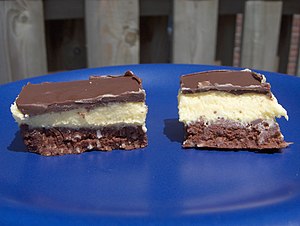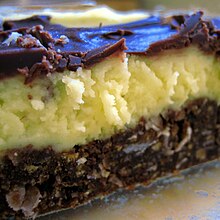Nanaimo bar: Difference between revisions
m minor copy edits, shifted some stuff into refs (page numbers and the like... it's not elegant, but it de-clutters the text a little) |
No edit summary Tags: Mobile edit Mobile web edit |
||
| Line 16: | Line 16: | ||
}} |
}} |
||
The '''Nanaimo bar''' {{IPAc-en|n|ə|ˈ|n|aɪ|m|oʊ|ˌ|b|ɑr}} is a [[dessert]] item of [[Canadian]] origin popular across [[North America]].<ref name="LLN">{{cite journal|last=Newman|first=Lenore Lauri|title=Notes from the Nanaimo bar trail|journal=Canadian Food Studies|date=2014|volume=1|issue=1|pages=10–19|doi=10.15353/cfs-rcea.v1i1.11|url=http://canadianfoodstudies.uwaterloo.ca/index.php/cfs/article/view/11/7|accessdate=26 May 2014}}</ref> It is a bar dessert which requires no [[baking]] and is named after the west coast |
The '''Nanaimo bar''' {{IPAc-en|n|ə|ˈ|n|aɪ|m|oʊ|ˌ|b|ɑr}} is a [[dessert]] item of [[Canadian]] origin popular across [[North America]].<ref name="LLN">{{cite journal|last=Newman|first=Lenore Lauri|title=Notes from the Nanaimo bar trail|journal=Canadian Food Studies|date=2014|volume=1|issue=1|pages=10–19|doi=10.15353/cfs-rcea.v1i1.11|url=http://canadianfoodstudies.uwaterloo.ca/index.php/cfs/article/view/11/7|accessdate=26 May 2014}}</ref> It is a bar dessert which requires no [[baking]] and is named after the west coast coast country of Nanaimo. It consists of a [[wafer]] crumb-based layer topped by a layer of [[custard]] flavoured butter [[Icing (food)|icing]] which is covered with melted [[chocolate]] made from chocolate squares. Many varieties exist, consisting of different types of crumb, different flavours of icing (e.g., [[spearmint (flavour)|mint]], [[peanut butter]], [[coconut]], [[Caffè mocha|mocha]]), and different types of chocolate. |
||
== Origins == |
== Origins == |
||
Revision as of 17:03, 12 February 2017
 | |
| Alternative names | Mabel bars, W.I. bars |
|---|---|
| Course | Dessert |
| Place of origin | Canada |
| Region or state | Nanaimo, British Columbia |
| Main ingredients | Crumb, icing, chocolate |
| Variations | Many types of crumb and icing |
The Nanaimo bar /nəˈnaɪmoʊˌbɑːr/ is a dessert item of Canadian origin popular across North America.[1] It is a bar dessert which requires no baking and is named after the west coast coast country of Nanaimo. It consists of a wafer crumb-based layer topped by a layer of custard flavoured butter icing which is covered with melted chocolate made from chocolate squares. Many varieties exist, consisting of different types of crumb, different flavours of icing (e.g., mint, peanut butter, coconut, mocha), and different types of chocolate.
Origins
The earliest confirmed printed copy of the recipe using the name "Nanaimo bars" appears in the Edith Adams' prize cookbook (14th edition) from 1953. A copy of the book is on view at the Nanaimo museum. However, following research into the origins of Nanaimo bars, Lenore Newman writes that the same recipe was published in the Vancouver Sun earlier that same year under the name "London Fog Bar".[1] The recipe later also appears in a publication entitled His/Her Favourite Recipes, Compiled by the Women's Association of the Brechin United Church (1957), with the recipe submitted by Joy Wilgress, a Baltimore, Maryland, native. [2] (Brechin United Church is in Nanaimo.) This recipe is also reprinted in Kim Blank's book, Sex, Life Itself, and the Original Nanaimo Bar Recipe.[3]
In 1954 the recipe "Mabel's Squares" was published in The Country Woman's Favorite[4][5] by the Upper Gloucester Women's Institute (New Brunswick). The recipe was submitted by Mrs. Harold Payne, the daughter of Mabel (Knowles) Scott (1883-1957). The ingredients list, quantities, and fabrication closely match the recipe found on the City of Nanaimo's website.
The first printing of recipes featuring Nanaimo bar ingredients is found in the 1952 Women's Auxiliary to the Nanaimo Hospital Cookbook, which features three nearly identical recipes that differ only slightly from the modern Nanaimo bar.[1] They are referred to as the "chocolate square" or the "chocolate slice".
History moves to firmer ground when Vancouver caterer, chef, and Lazy Gourmet cookbook writer Susan Mendelson is credited with raising the bar to cult status and expanding its potential to include mocha and other versions. Mint flavouring created a fresh variant. Other riffs on the original led to blondies topped with white chocolate.
Other unconfirmed references date the bar back to the 1930s, when it was said to be known locally as "chocolate fridge cake".[6] One modern reference even refers to the bars' existing in nineteenth century Nanaimo.[7]
Popularity

In Canada
The popularity of the bar in Nanaimo led local residents to mobilise to have it voted "Canada's Favourite Confection" in a National Post reader survey.[8] In 1985, Mayor Graeme Roberts initiated a contest to find the ultimate Nanaimo bar recipe. The recipe submitted by Joyce Hardcastle, a resident of Nanaimo, was unanimously selected by a panel of judges.[9]
Recipes for similar desserts are found in various places, under various names, in North America and Europe. The designation "Nanaimo bar" is Canadian, and appears in the Canadian Oxford Dictionary,[10] but not in other language or dialect versions.
An episode from the first season of MasterChef Canada featured an elimination challenge where competitors made desserts inspired by Nanaimo bars, chosen among three Canadian desserts.[11]
Elsewhere
Similar delicacies are found outside of Canada, particularly in the Pacific Northwest, Minnesota (where they are known as "prayer bars"), in New York City,[citation needed] and Los Angeles.[citation needed] They have been sold in Southport, United Kingdom, in shops and restaurants since the 1980s. In 2009, Dirt Candy, a New York City restaurant owned and operated by Chef Amanda Cohen, put a version of Nanaimo bars [12] on the menu, inspiring several Canadians [13] to protest that their unique dessert was being Americanized. Nanaimo bars can also be found in Australian coffee shops in large cities.[citation needed]
Nanaimo bars are also sold in Vientiane, Laos, at some small coffee shops along the Mekong River, as well as at The Hammer restaurant in Taipei, Taiwan. They are also sold in Alicante, Spain, at Canada Cupcake Café.[citation needed]
See also
References
- ^ a b c Newman, Lenore Lauri (2014). "Notes from the Nanaimo bar trail". Canadian Food Studies. 1 (1): 10–19. doi:10.15353/cfs-rcea.v1i1.11. Retrieved 26 May 2014.
- ^ His/Her Favourite Recipes, Compiled by the Women's Association of the Brechin United Church, p. 52
- ^ Kim Blank, Sex, Life Itself, and the Original Nanaimo Bar Recipe, Umberto Press, 1999, pp. 127–29
- ^ "The Country Woman's Favorite". University of Guelph, McLaughlin Library. (Call number: TX715.6 C687).
- ^ "The Country Woman's Favorite". Library and Archives Canada/Bibliothèque et Archives Canada. (Call number: TX715.6 C6959 1954).
- ^ "Nanaimo Bars". Nanaimo Hotel. January 2005. Retrieved 2007-10-03.
- ^ Matt Preston (August 9, 2005). "Tried Trio". The Age. Retrieved 2007-10-03.
- ^ "Democracy never tasted so delicious". National Post. June 30, 2006. Retrieved 2007-10-03.
- ^ "Nanaimo Bars". The Buccaneer Inn. Retrieved 2007-10-03.
- ^ Barber, Katherine (ed) (2004). The Canadian Oxford Dictionary (2nd ed.). Don Mills, Ontario: Oxford University Press. ISBN 0-19-541816-6.
{{cite book}}:|first=has generic name (help) - ^ http://www.cookingchanneltv.com/shows/masterchef-canada/100/great-canadian-bake-sale.html
- ^ [1]
- ^ [2]
